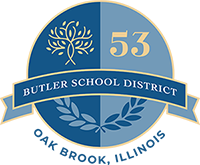
Butler District 53 released its Student Achievement and Performance Report for 2017-18. It details the results of three assessments and is released annually. Two are student administered academic tests – The Partnership for Assessment of Readiness for College and Careers, or PARCC, is a state test for grades 3-8 and the NWEA MAP is a nationally normed test. The MAP test is adaptive, adjusting to each student’s performance, and precisely measures achievement and growth. The third is a state survey of teachers, students in grades 5-8 and parents, called the 5Essentials.
In summary, on the rigorous PARCC test, Butler 53 has been one of the highest performing districts in the state and both schools have been designated as “Exemplary” by the Illinois State Board of Education.
- On the PARCC test, 75 percent of students in math met or exceeded standards and another 18 percent approached standards. This compares to 33 percent who met or exceeded standards in the state. In English Language Arts, 82 percent of Butler students met or exceeded standards with another 14 percent approaching standards. This compares to the 37 percent across the state.
- Thirty percent of Butler students exceeded standards in math and ELA compared to 5-6 percent in the state.
- Butler 53 has outperformed almost all of the District’s historically designated comparable schools in reading and math, as measured by PARCC.
- The 2017-18 PARCC results for students with Individual Education Plans (IEP) who met or exceeded state standards was 40 percent in reading and 47 percent in math. This was much higher than the state average of 9 percent and 8 percent, respectively for reading and math, as measured by PARCC.
- Butler students, on average, perform at 2-3 grade levels above the national norm, as measured by the MAP assessment.
- End of year attainment scores for NWEA MAP were more than 95th percentile in reading and math across all grade levels, which evidences distinguished academic achievement.
- In 2017-18, overall 69 percent students in reading and 60 percent students in math met their typical growth target as prescribed by MAP.
- Based on their average RIT score in fall and spring for the academic year 2017-18, overall students are in the top 1-5 percent nationally for reading and in the top 1-2 percent nationally for math.
Superintendent Dr. Heidi Wennstrom said that great efforts were made to improve ELA instruction and the results reflect that. She said the focus is now on fine turning math instruction as well as to focus across the board on each student’s growth. “Our teachers are ensuring stretch instructional strategies are implemented across all content areas. Our teachers should be recognized for the improvements that have led us to ensure that students are attaining this high level of achievement,” she said. “The District will continue to ensure lower performing students receive intensive and targeted support as well as attending to the needs of the higher performing students to assist them with meaningful and effective enrichment.”
The 5Essentials survey was given to teachers, parents and students in grades 5-8. It looks at five areas of the schools related to organization and climate – ambitious instruction, effective leaders, collaborative teachers, involved families and supportive environment. “We have exceptional administrators and teachers who are working in collaboration to build a culture of learning and trust,” said Wennstrom.
At Brook Forest, the highest performing indicator was “involved families,” “collaborative teachers” and “effective leaders.” On specific questions, Brook Forest showed high performance on “few classroom disruptions” (99), “parent influence on decision making in schools” (99), “quality of student discussion” (99), “socialization of new teachers” (99) and “teacher-parent trust” (99). Areas of increase were in “teacher-principal trust” (+22), “quality professional development” (+14), “instructional leadership” (+10), “teacher-teacher trust” (+9) “and collective use of assessment data.” (+7).
At Butler Junior High, the highest performing indicator was “involved families,” followed by “ambitious instruction,” “supportive environment”, “collaborative teachers” and “effective leaders.”
On specific questions, Butler Junior High showed high performance on “few classroom disruptions” (99), “collective responsibility” (99), “math instruction” (99), “parent influence on decision making in schools” (99) and “quality of student discussion” (99). Areas of increase were in “student reflective dialogue” (+41), “student-teacher trust” (+16), “collaborative practices” (+6), “quality professional development” (+6) and “student responsibility” (+6).
The results of all three assessments are extensively analyzed to improve instruction and school culture, said Wennstrom. Teachers also conduct a “deep dive” into the data on individual students to ensure that they are meeting standards and growing in each instructional area.
“This positive learning culture enables us to achieve at the historical high levels. Our teachers are dedicated to instructional renewal by participating in professional learning teams that examine best instructional strategies and incorporate student data with an intense focus on individualized student growth,” Wennstrom said.
